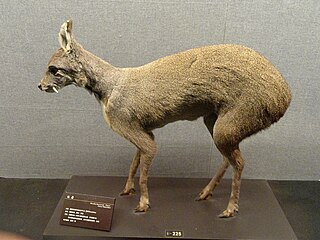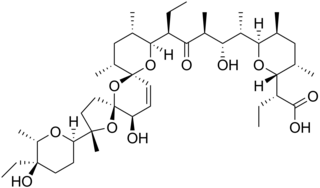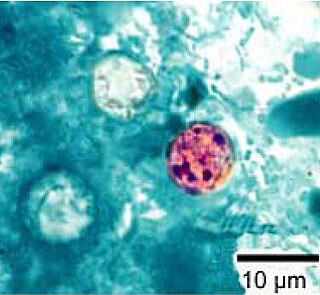
The Arctic hare is a species of hare highly adapted to living in the Arctic tundra and other icy biomes. The Arctic hare survives with shortened ears and limbs, a small nose, fat that makes up close to 20% of its body, and a thick coat of fur. It usually digs holes in the ground or under the snow to keep warm and to sleep. Arctic hares look like rabbits but have shorter ears, are taller when standing, and, unlike rabbits, can thrive in extreme cold. They can travel together with many other hares, sometimes huddling with dozens or more, but are usually found alone, sometimes taking more than one partner. The Arctic hare can run up to 60 kilometres per hour (40 mph).
Coccidiosis is a parasitic disease of the intestinal tract of animals caused by coccidian protozoa. The disease spreads from one animal to another by contact with infected feces or ingestion of infected tissue. Diarrhea, which may become bloody in severe cases, is the primary symptom. Most animals infected with coccidia are asymptomatic, but young or immunocompromised animals may suffer severe symptoms and death.

Eimeria tenella is a species of Eimeria that causes hemorrhagic cecal coccidiosis in young poultry. It is found worldwide.

Eimeria is a genus of apicomplexan parasites that includes various species capable of causing the disease coccidiosis in animals such as cattle, poultry and smaller ruminants including sheep and goats. Eimeria species are considered to be monoxenous because the life cycle is completed within a single host, and stenoxenous because they tend to be host specific, although a number of exceptions have been identified. Species of this genus infect a wide variety of hosts. Thirty-one species are known to occur in bats (Chiroptera), two in turtles, and 130 named species infect fish. Two species infect seals. Five species infect llamas and alpacas: E. alpacae, E. ivitaensis, E. lamae, E. macusaniensis, and E. punonensis. A number of species infect rodents, including E. couesii, E. kinsellai, E. palustris, E. ojastii and E. oryzomysi. Others infect poultry, rabbits and cattle. For full species list, see below.

Eimeria maxima is a protozoan that causes coccidiosis in poultry. It is located in the middle part of the intestine, on either side of Meckel's diverticulum, and frequently ascends into the duodenum. The lesions it causes are limited to the middle of the small intestine.

The dwarf musk deer or Chinese forest musk deer is an artiodactyl native to southern and central China and northernmost Vietnam. The species name is after the collector Mikhail Mikhailovich Berezovsky. On June 14, 1976, China entered the dwarf musk deer onto its endangered species list. Four subspecies are recognized:

The Eucoccidiorida are an order of microscopic, spore-forming, single-celled parasites belonging to the apicomplexan class Conoidasida. Protozoans of this order include parasites of humans, and both domesticated and wild animals including birds. Among these parasites are the Toxoplasma gondii that cause toxoplasmosis and Isospora belli, which results in isosporiasis.

The blunt-eared bat or Peruvian crevice-dwelling bat is a species of bat in the family Molossidae. It is monotypic within the genus Tomopeas and subfamily Tomopeatinae. It is endemic to Peru, where it is considered critically endangered. It is threatened by habitat loss.

Diclazuril is a coccidiostat.

Narasin is a coccidiostat and antibacterial agent. It is a derivative of salinomycin with an additional methyl group. Narasin is produced by fermentation of a strain of Streptomyces aureofaciens.
Eimeriorina is a suborder of phylum Apicomplexa.

Eimeriidae is a family of Apicomplexa. It contains the following genera:
Eimeria kinsellai is an apicomplexan parasite of the genus Eimeria that infects the marsh rice rat. It was discovered in 1970 at Paynes Prairie, Alachua County, Florida. A different Eimeria, Eimeria palustris, has been found in Alabama marsh rice rats. E. kinsellai differs from other Eimeria found in rice rats, such as Eimeria couesii, Eimeria oryzomysi, Eimeria ojastii, and E. palustris, in anatomical details. It was named after parasitologist John M. Kinsella.
Eimeria palustris is an apicomplexan parasite of the genus Eimeria that infects the marsh rice rat. It was discovered in 1970 at Tuskegee National Forest, Macon County, Alabama. A different Eimeria, Eimeria kinsellai, has been found in Florida marsh rice rats. E. palustris differs from other Eimeria found in rice rats, such as Eimeria couesii, Eimeria oryzomysi, Eimeria ojastii, and E. kinsellai, in anatomical details. Its specific epithet refers to that of its type host, Oryzomys palustris.
Eimeria couesii is an apicomplexan parasite of the genus Eimeria that infects the intestine of the rice rat Oryzomys couesi in Mexico. It has an oocyst residuum and Stieda bodies, structures that are absent in some other Eimeria.

Cyclospora is a genus of apicomplexan parasites. It includes the species Cyclospora cayetanensis, the causative agent of cyclosporiasis. Members of Cyclospora are characterized as having oocysts with two sporocysts, each containing two sporozoites.
Calyptospora is a genus of parasitic protozoa in the phylum Apicomplexa.
Eimeria zuernii is a species of the parasite Eimeria that causes diarrheic disease known as eimeriosis in cattle, and mainly affects younger animals. The disease is also commonly referred to as coccidiosis. The parasite can be found in cattle around the globe.
Eimeria arlongi is a species of Eimeria that causes clinical coccidiosis in goats. It and Eimeria ninakohlyakimovae are two of the most pathogenic species for goats. It is particularly prevalent in goat kids in Iran. Issues with coccidiosis specifically due to Eimeria arloingi have also been reported in Egypt and Portugal. It is unclear whether this species is present in the Americas as most of the case reports of coccidiosis in these areas do not differentiate the species causing the disease. Infections with this species are commonly compounded by infections with other Eimeria species in "mixed infections." This species is closely related to Eimeria bovis and Eimeria zuernii which are both highly pathogenic in cattle' Infections with this species are characterized by lesions specifically in the jejunum, but also the ilium and cecum which results in diarrhea. Oocysts begin shedding between 16 and 18 days after the animal is infected which is when the parasite is spread. The shedding can last as long as 15 days. This parasite causes an immune response in its host that includes accumulation of fluid in body cavities, presence of large numbers of leukocytes in the small intestine, and necrosis of the tissue of the small intestine. Pale yellow plaques can be seen on the small intestine of severely affected kids at necropsy.
Eimeria bovis is a parasite belonging to the genus Eimeria and is found globally. The pathogen can cause a diarrheic disease in cattle referred to as either eimeriosis or coccidiosis. The infection predominantly cause disease in younger animals.









